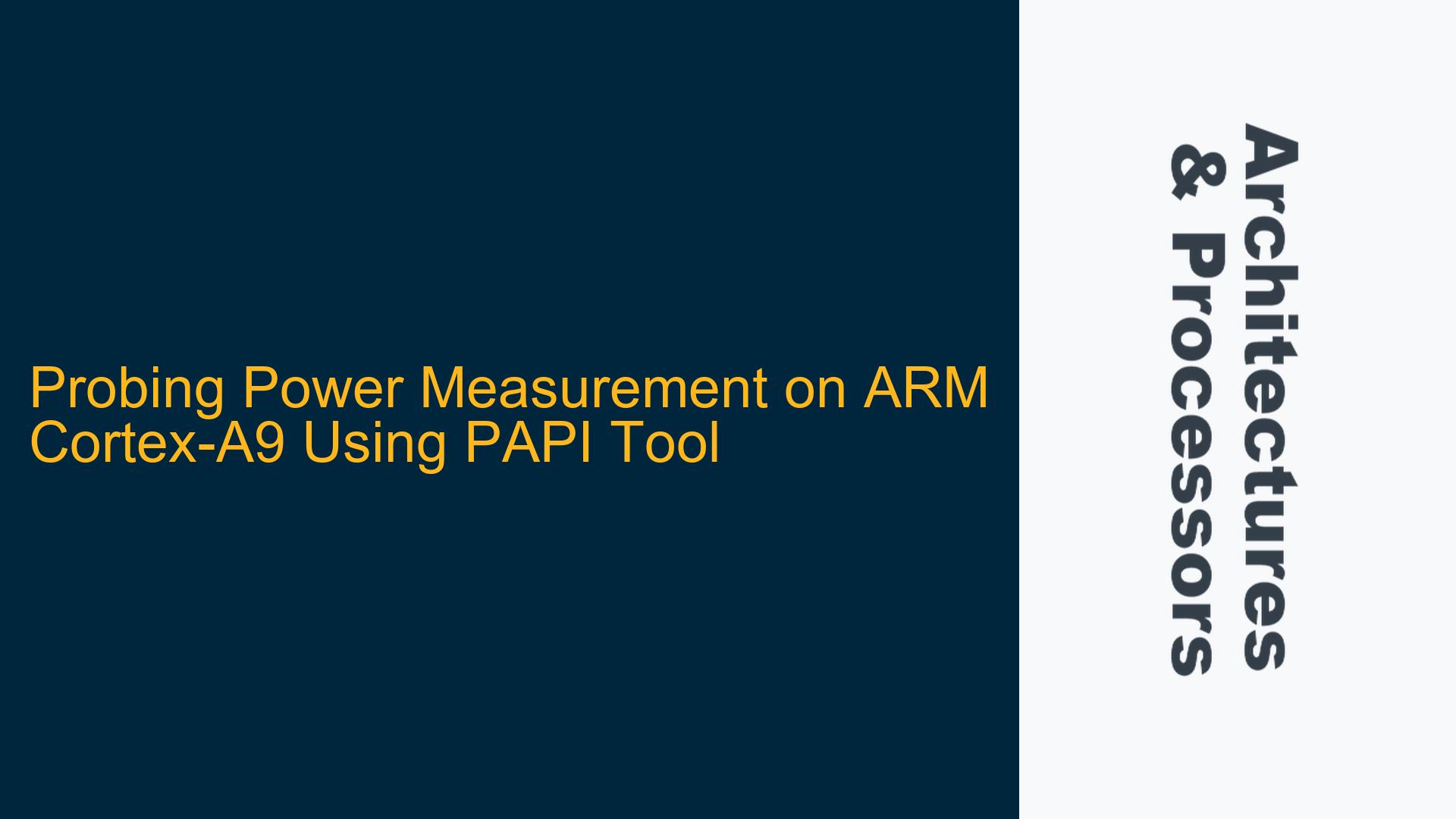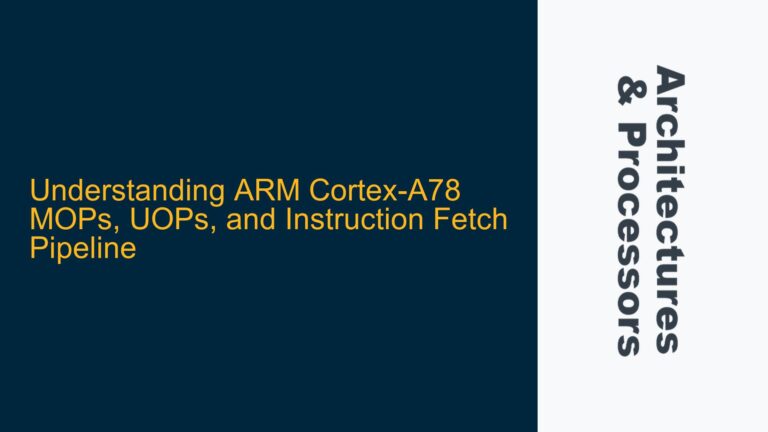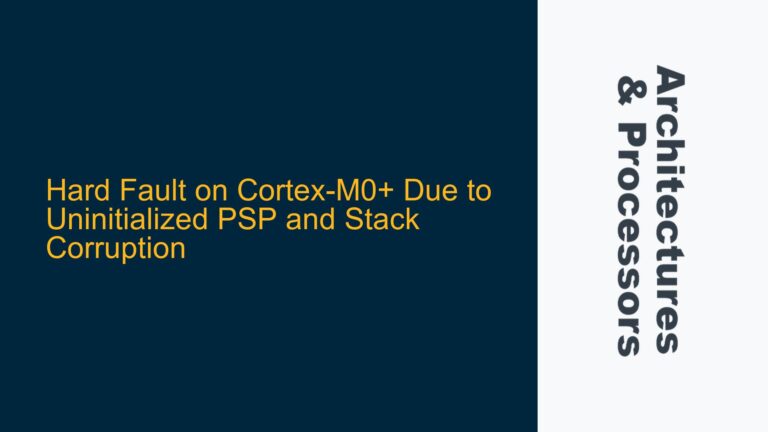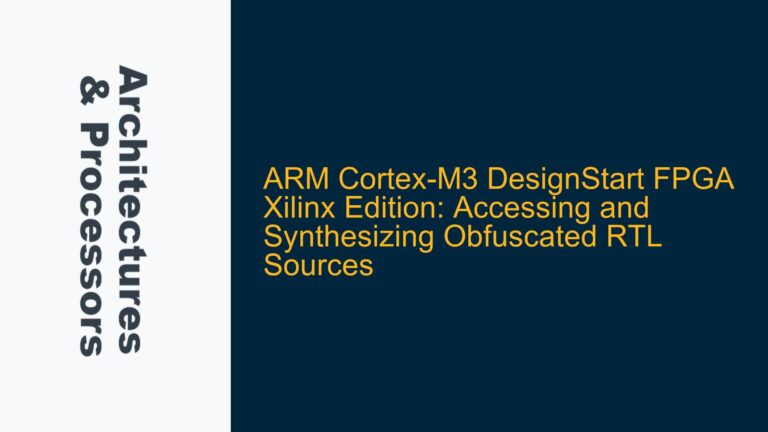ARM Cortex-A9 Power Measurement Challenges with PAPI
The ARM Cortex-A9 processor, part of the ARMv7-A architecture, is widely used in embedded systems for its balance of performance and power efficiency. However, measuring power consumption on such processors, especially when running cryptographic algorithms or other compute-intensive tasks, can be challenging. The Performance Application Programming Interface (PAPI) is a popular tool for accessing hardware performance counters, but its use for power measurement on ARM Cortex-A9 processors is not straightforward. This post delves into the intricacies of using PAPI for power measurement on ARM Cortex-A9, the potential pitfalls, and the solutions to achieve accurate power profiling.
Power Measurement on ARM Cortex-A9: Understanding the Context
The ARM Cortex-A9 processor does not have dedicated hardware performance counters for direct power measurement. Instead, power consumption is typically inferred from other performance metrics such as CPU utilization, cache misses, and memory bandwidth. These metrics can be accessed via performance counters, which are programmable registers that count specific hardware events. PAPI provides a high-level interface to these counters, but it requires careful configuration and interpretation to estimate power consumption.
The Zedboard, which features a Zynq-7000 All Programmable SoC, integrates a dual-core ARM Cortex-A9 processor. When running Linux on this platform, the performance counters are accessible through the Linux kernel’s performance monitoring infrastructure. However, the relationship between these counters and power consumption is not direct. Power estimation requires correlating performance counter data with known power models or empirical measurements.
Misconfigured PAPI Counters and Uncore Events
One of the primary challenges in using PAPI for power measurement on ARM Cortex-A9 is the misconfiguration of performance counters. PAPI supports a wide range of counters, but not all are relevant for power estimation. The term "uncore" refers to parts of the processor that are not part of the core itself, such as the L2 cache, memory controller, and interconnect. Uncore events can provide insights into power consumption, but they are often overlooked or misconfigured.
For example, the ARM Cortex-A9 Performance Monitoring Unit (PMU) includes counters for L1 and L2 cache accesses, branch predictions, and memory transactions. These events can be used to infer power consumption, but only if they are correctly mapped to power models. Misconfiguring these counters can lead to inaccurate power estimates or even system crashes due to counter overflows.
Another issue is the lack of direct support for power-related counters in PAPI. While PAPI provides a generic interface for accessing performance counters, it does not include specific functions for power measurement. This requires developers to manually configure the counters and interpret the results, which can be error-prone.
Implementing Power Estimation with PAPI and Performance Counters
To accurately estimate power consumption on ARM Cortex-A9 using PAPI, follow these steps:
-
Identify Relevant Performance Counters: Start by identifying the performance counters that are most relevant for power estimation. These include counters for CPU utilization, cache accesses, memory bandwidth, and branch predictions. Use the ARM Architecture Reference Manual to understand the available counters and their meanings.
-
Configure PAPI for ARM Cortex-A9: Cross-compile PAPI for the ARM Cortex-A9 architecture. Ensure that the PAPI library is correctly linked with your application and that the necessary kernel modules for performance monitoring are loaded. Use the
PAPI_library_initfunction to initialize PAPI andPAPI_create_eventsetto create an event set for power-related counters. -
Map Counters to Power Models: Develop or use an existing power model that correlates performance counter data with power consumption. This model should account for the specific characteristics of the ARM Cortex-A9 processor, such as its power states, clock frequencies, and voltage levels. Use empirical measurements to validate the model.
-
Read and Interpret Counter Data: Use PAPI functions such as
PAPI_add_eventandPAPI_startto start counting events. Periodically read the counter values usingPAPI_readand update the power model. Ensure that counter overflows are handled correctly by using large enough data types and resetting counters as needed. -
Validate and Refine the Power Estimate: Compare the estimated power consumption with actual measurements using external power meters or on-chip sensors. Refine the power model and counter configuration based on the observed discrepancies.
-
Optimize for Real-Time Monitoring: If real-time power monitoring is required, optimize the PAPI configuration to minimize overhead. This may involve reducing the number of counters, increasing the sampling interval, or using hardware acceleration features.
By following these steps, you can effectively use PAPI to estimate power consumption on ARM Cortex-A9 processors. However, keep in mind that power estimation is inherently approximate and depends on the accuracy of the underlying power model. Regular validation and refinement are essential to ensure reliable results.
Alternative Approaches for Power Measurement on ARM Cortex-A9
While PAPI is a powerful tool for performance analysis, it is not the only option for power measurement on ARM Cortex-A9. Alternative approaches include:
-
On-Chip Power Sensors: Some ARM processors, including the Cortex-A9, include on-chip power sensors that provide direct measurements of power consumption. These sensors can be accessed via the processor’s debug interface or through specialized software tools. However, they may not be available on all platforms or may require additional hardware support.
-
External Power Meters: External power meters can provide accurate measurements of power consumption but require physical access to the processor’s power supply lines. This approach is often used for validation and calibration but is not practical for continuous monitoring.
-
Simulation and Emulation: Power consumption can be estimated using simulation or emulation tools that model the processor’s behavior at the circuit level. These tools provide detailed insights into power consumption but are computationally expensive and may not be suitable for real-time analysis.
-
Linux Kernel Modules: The Linux kernel includes modules for power management and performance monitoring that can be used to estimate power consumption. These modules provide access to performance counters and power states but require kernel-level programming and may not be as flexible as PAPI.
Each of these approaches has its advantages and limitations, and the choice depends on the specific requirements of the application. In many cases, a combination of methods is used to achieve the best results.
Conclusion
Measuring power consumption on ARM Cortex-A9 processors using PAPI is a complex but achievable task. By understanding the relevant performance counters, configuring PAPI correctly, and developing accurate power models, you can obtain reliable power estimates for your applications. However, it is important to validate these estimates using alternative methods and to continuously refine the approach based on empirical data. With careful implementation, PAPI can be a valuable tool for power analysis on ARM Cortex-A9 and other embedded processors.






